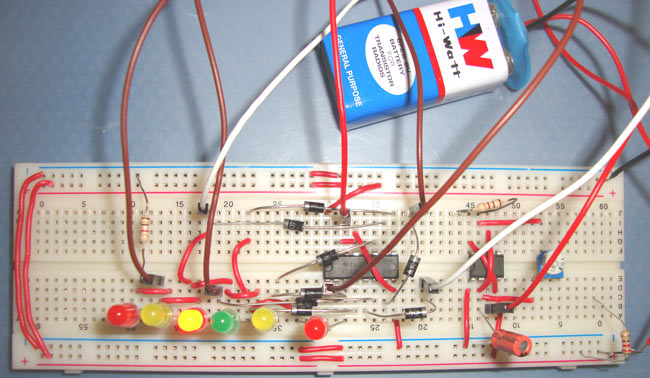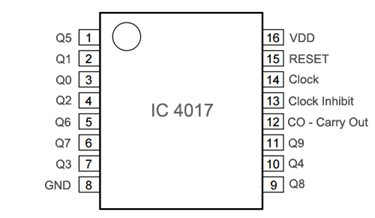
Dancing LEDs circuit is used for decorative purpose and looks very good when these LEDs glow in sequential manner. We can create many kind of Dancing LEDs patterns for decoration. In this particular circuit, we have created a pattern in which 6 LEDs are illuminating in forward and reverse order. To create this circuit we have mainly used 555 timer IC and 4017 IC.
4017 IC is a CMOS decade counter chip. It can produce output at the 10 pins (Q0 – Q9) sequentially, means it produce output one by one at the 10 output pins. This output is controlled through the clock pulse at PIN 14. At first, output at Q0 (PIN 3) is HIGH, then with each clock pulse, output advance to the next PIN. Like one clock pulse makes the Q0 LOW and Q1 HIGH, and then the next clock pulse makes the Q1 LOW and Q2 HIGH, and so on. After the Q9, it will start from the Q0 again. So it creates sequential ON and OFF of all the 10 OUTPUT PINs. Below is the PIN diagram and PIN description of 4017:

|
PIN NO. |
PIN Name |
PIN Description |
|
1 |
Q5 |
Output 5: Goes high in 5 clock pulse |
|
2 |
Q1 |
Output 1: Goes high in 1 clock pulse |
|
3 |
Q0 |
Output 0: Goes high at the beginning – 0 clock pulse |
|
4 |
Q2 |
Output 2: Goes high in 2 clock pulse |
|
5 |
Q6 |
Output 6: Goes high in 6 clock pulse |
|
6 |
Q7 |
Output 7: Goes high in 7clock pulse |
|
7 |
Q3 |
Output 3: Goes high in 3 clock pulse |
|
8 |
GND |
Ground PIN |
|
9 |
Q8 |
Output 8: Goes high in 8 clock pulse |
|
10 |
Q4 |
Output 4: Goes high in 4 clock pulse |
|
11 |
Q9 |
Output 9: Goes high in 9 clock pulse |
|
12 |
CO –Carry out |
Used to cascade another 4017 IC to makes it count upto 20, it is divide by 10 output PIN |
|
13 |
CLOCK inhibit |
Clock enable pin, should kept LOW, keeping HIGH will freeze the output. |
|
14 |
CLOCK |
Clock input, for sequentially HIGH the output pins from PIN 3 TO PIN 11 |
|
15 |
RESET |
Active high pin, should be LOW for normal operation, setting HIGH will reset the IC (only Pin 3 remain HIGH) |
|
16 |
VDD |
Power supply PIN (5-12v) |
Required Components
- CD4017 IC
- 555 Timer IC
- 2 Resistor- 1k
- Capacitor- 10uF
- Variable Resistor- 10K
- Diodes- 8 (1n4148 preferred)
- 6 LEDs
- Battery - 9v
We have connected 6 LEDs to the output Q0 to Q5, now after 6 LEDs we need to glow them in reverse order. To achieve this, we have connected middle 4 LEDs to the output Q6-Q9 too. Means middle 4 LEDs are connected to the two outputs i. e. Q1-Q4 and Q6-Q9. Diodes have been used to connect middle 4 LEDs, to prevent the reverse current flow, so that when one output is HIGH, current can’t be gone through another connected output. So now finally, LED 1 to 6 glows, then LED 5 to 2 glows (reverse) and then again LED 1 to 6 glows, then 5-2 again and so on.
To apply the clock pulse at PIN 14, we have used 555 timer IC in Astable mode. The oscillated output generated at PIN 3 of 555 has been applied to the PIN 14 of 4017, so that output can be advanced with each clock pulse. We can control the speed of flashing LEDs by using the potentiometer (RV1), rotating the potentiometer knob will change oscillation frequency of 555 timer, hence the rate of clock pulse. The frequency of the 555 can be calculated using this formula: F=1.44/((R1+2*RV1)*C1)
You can further change the illumination pattern by changing the LED sequence.
Comments
Circuit is very easy, please
Circuit is very easy, please check your circuit connections again.
dancing light
I connected everything as shown in the diagram. The LED came on but it didn't switch to another LED although whenever i remove power and place it back, another LED comes on.
Its pretty common with
Its pretty common with electronics to not get output in your first try. Learn to debug your circuit so that you can make it work. Checking your connections, checking continuity, pinouts and voltage levels are some common debug techniques







this dancing led is not will working i follow the diagram but still not work on